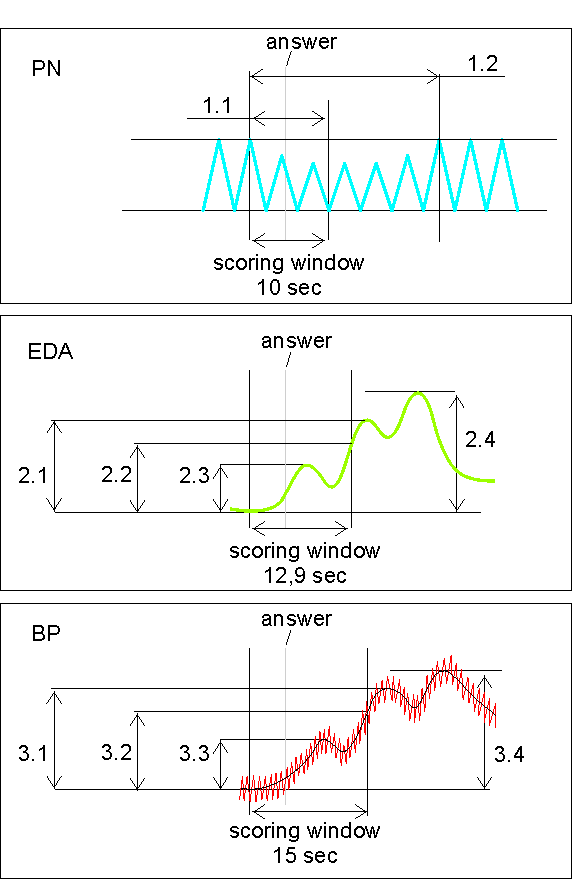|
Author
|
Topic: Kircher measurements
|
skar
Member
|
 posted 11-28-2010 04:24 AM
posted 11-28-2010 04:24 AM
  
"To measure or not to measure. That is the question!"I want to use Kircher measurements, but I'd like to understand more exactly some details. I was taught to measure the response which occurs after the question onset with some minimum latency and the response must begin no later than 5 seconds after the subject's answer. I did not use the term "scoring window". As I understand, Raskin and Kircher (1988) used 0-10 seconds following the question onset as scoring window for PN, 0.5-20 and 0-20 seconds following the question onset as scoring windows for SC and BP. But I don`t understand was there time period besides 20 seconds, where the response was deemed timely (responce onset window, DODPI 2006) The last scoring windows I know:
PN - 0-10 sec
EDA - 0.5-12.9 sec
BP - 0-15 sec What does this scoring windows mean?
1. Do we must measure from the low point of a response curve to the subsequent high point only within scoring window?
In this case, is there another time period besides 10, 12.9, 15 seconds, where the response was deemed timely?
or
2. The scoring window is a window where the responce only is deemed timely and we can measure from the low point of the response to the subsequent high point within the scoring window or out of them for EDA and BP, for example. For example. The figures below is schematic. The numerals near the arrows are ordinal numbers of the measurements.
What measurements are correct?
Thanks.
 [This message has been edited by skar (edited 11-28-2010).] IP: Logged |
Barry C
Member
|
 posted 11-29-2010 02:27 PM
posted 11-29-2010 02:27 PM
  
When the algorithms "score" the data, they don't "see" anything beyond the pre-defined scoring windows, which are not arbitrary. (According to Dr. Kircher, the 10.0 second window just happened to work best. It wasn't 10.1 or 9.9: it was 10.0.)Generally, the algorithms outperform hand-scorers. Of course, reliability is 100% if the computer does the measuring. The question is whether the data is good data and worthy of consideration. By that, I don't mean you should consider all the folklore surrounding a "good," "real," or whatever reaction, but whether the data is not an artifact. Are there going to be times when the algorithms "chop off" a reaction. Sure. But, on average, you're going to get the correct result most of the time, and you won't do any worse than most hand-scorers. Remember: no scoring system is 100% accurate, and we often criticize the 5 to 10% errors as needless if we just revert back to "I was taught this piece of folklore that solves the problem." In the end all we can do is compare the computer to people, and that's been done. Each may be prone to different errors, but resorting back to technical fixes (as has been our historical approach) hasn't seemed to work well at all. IP: Logged |
skar
Member
|
 posted 02-05-2011 05:30 AM
posted 02-05-2011 05:30 AM
  
I have seen the CPS program. In my understanding the CPS algorithm measures from the low point of the response to the subsequent high point within the scoring window or out of it if the response occurs within the scoring window for EDA and BP. In my example above the correct Kircher measurement would be ¹ 2.1.
[This message has been edited by skar (edited 02-05-2011).] IP: Logged |
Barry C
Member
|
 posted 02-07-2011 07:01 PM
posted 02-07-2011 07:01 PM
  
Here's what CPS will score. The yellow is from the program - not me. It "looks" at the trend line you see through the cardio. The measurement stops even though the reaction continues to rise (a little).
IP: Logged |
skar
Member
|
 posted 02-07-2011 07:32 PM
posted 02-07-2011 07:32 PM
  
quote:
The measurement stops even though the reaction continues to rise (a little).
I think, the measurement was stopped because the reaction come down and the next rise began out of the 15 sec scoring window. If reaction didn't came down, the measurement wouldn't be stopped. Also, the measurement wasn't stopped at the 15 sec. It is the same case as with the measurements ¹ 2.1, 3.1 in my example above.[This message has been edited by skar (edited 02-08-2011).] IP: Logged | |


 Polygraph Place Bulletin Board
Polygraph Place Bulletin Board

 Professional Issues - Private Forum for Examiners ONLY
Professional Issues - Private Forum for Examiners ONLY

 Kircher measurements
Kircher measurements






